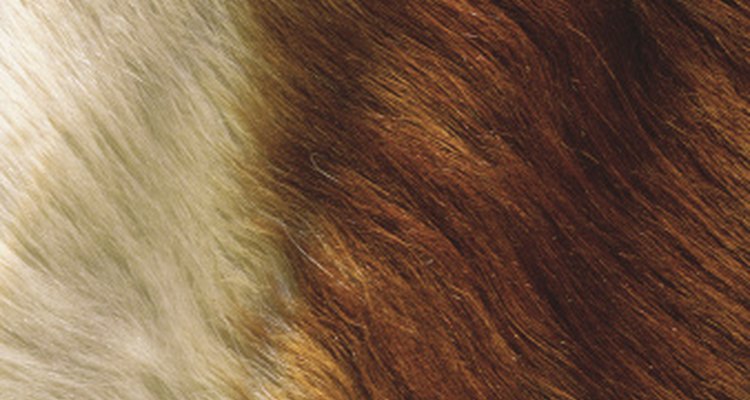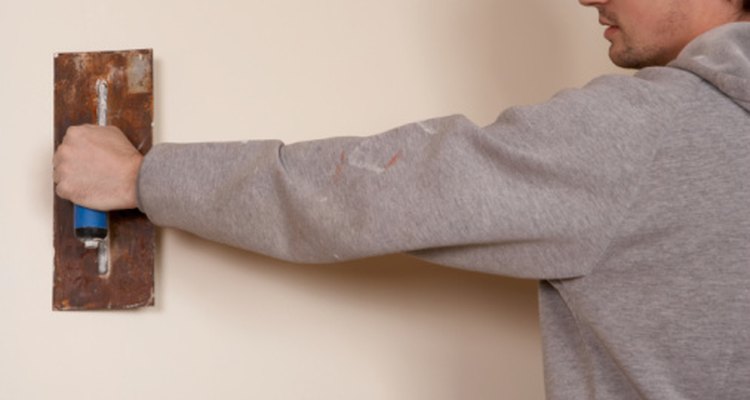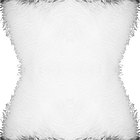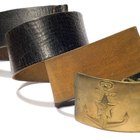
Suede is leather made from any animal hide. Anything that is made from an animal hide, such as a football, jacket, or linings for boots or jackets, is leather. Suede is a type of leather made from a split piece of animal hide. Depending on the animal, some hides are thicker than others, allowing you to split it two or three times. Suede is different in the fact that it is sanded on one side until it is soft and supple. Suede is not treated; therefore, if it gets wet, it will show water marks.

Soak the hide in hot water overnight. Cover your container with a lid or towel. Squeeze out excess water by any means other than ringing. An old-fashioned wringer-washer works well. Hang the hide on a clothes-line until it is just damp.

Scrape off the membrane and hair with a dull spade or trowel. Scrape the hair off by scraping in the direction the hair was growing. All of the hair and membrane will not come off on the first pass.

Place one pound of cow brains in a blender and blend for 30 seconds. The fat and other minerals in the brains will loosen the hair and membrane while softening the hide. Heat the blended brains until just before boiling, then add them to five gallons of warm water and stir until well-blended. Add the water with brains to the ten-gallon container and fill to three-quarters full with cold water. Soak the hide overnight. Use a brick or other heavy item to weigh the hide down. Cover the can or bucket with a lid or towel.

Switch the hide from the bucket with brains to a bucket of clean, lukewarm water. Swish the hide to remove brain residue, then squeeze out the excess water. Hang to dry until damp. Finish scraping off all hair and membrane.
Trim any hanging pieces of the hide, such as the lower legs or neck areas. Cut vertical lace slots, five inches apart, all around the four sides. Make the lace slots an inch long and a little less than an inch from the edges. Thread the parachute cord and lace the hide with it; one lace per slot. Tie the laces to the nails on the frame for stretching.

Stretch the hide for several days. Once the hide is the size you need, split the end of one corner to the thickness you desire for the suede. Continue the cut, moving slowly down and through the middle of the hide until you have two separate pieces.

The thinner hide, now left on the frame, can be sanded by hand or by using an electric buffer. Move side to side until the leather is almost ready, then begin sanding up and down to complete the softening of the leather to make suede. The piece that had fur -- the piece that was split and cut away -- can be worked with the buffer to remove any remaining fur, then placed on the frame to sand the other side until it becomes suede.
Related Articles

How Make Fat Liquor Furs

Sheepskin Vs. Deerskin

How to Make Clothing Out of Deer Hide

How to Clean Mud Off of Suede

How to Make Homemade Gaffs

Difference Between Genuine Leather ...

How to Hand Sew a Tear in Pants

How to Cook Textured Vegetable Protein ...

How to Make a Fake Goatee

How to Cut Up Your Deer Tenderloins

How to Make a Cone Hat With Felt

How to Repair Leather Handbag Handles

How to Fix a Ripped Winter Coat

How to Treat Doc Martens With Mink Oil

Removing Hair Extensions With Acetone

How to Stop a Running Split Fingernail

What Are Pig Snouts Used For?

How to Make Yarn Dreads and Braids

How Can I Take the Shine Off My Fake ...

How to Cut Bangs With a Cow Lick
References
Writer Bio
Barbara Stanley has been writing since 2003. Her stories have appeared in many national publications such as "Country Woman," "Wildbird," "Grit," "Capper's" and over a dozen more. She has a story on past loves published in the book, "If only I Could Tell You." Stanley has studied at the Pearl River Community College and the University of Southern Mississippi.
Photo Credits
Hemera Technologies/AbleStock.com/Getty Images